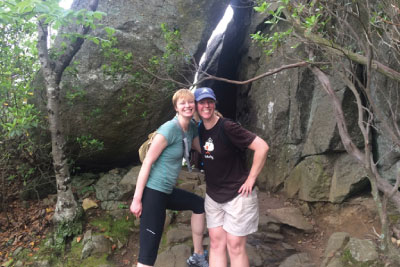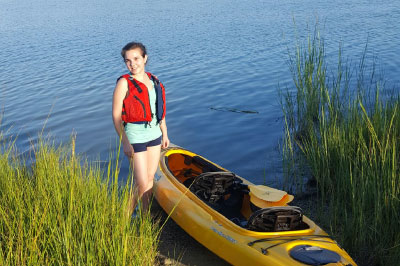
Over the past several years, NRPA has worked with the Centers for Disease Control and Prevention to promote the Surgeon General’s Call to Action on Walking and Walkability. Through this work we have created the Safe Routes to Parks initiative to ensure safe and equitable access to parks. On the local level, partnerships are a key to success in these initiatives but they are also vital at the national level.
In support of the Every Body Walk! Parks and Trails month, we wanted to highlight a few of our national partners and highlight how you could work with your local level counterparts to ensure that we all have safe and equitable access to parks!
Margo Pedroso, Deputy Director, Safe Routes to School National Partnership

Safe Routes to School initiatives have historically been focused on the walk to school (safer streets, bike and pedestrian planning, walking school busses etc.), why do you care about parks and safe access to parks? And how could Safe Routes to School professionals partner with park and recreation professionals to achieve Safe Routes to Parks?
The Safe Routes to School National Partnership originally focused primarily on the walk between homes and schools, but over the years we have expanded our mission to focus on safe walking and bicycling in daily life for kids and families. Improving access to parks gives kids and families greater opportunities for physical activity and healthy living, and is particularly important for low-income families. Plus, we have seen many parks and trails serve as part of a safe route to school.
At the local level, Safe Routes to School professionals and park and recreational professionals could join together to do walk audits and plan safe routes for kids and families, with parks and schools as key destinations. Together, they have a larger constituency than alone to make the case that local resources should be spent on improving safety along key routes.
What is your favorite park or trail to take a walk?
The nearest parks are about 2-3 miles away, so I’m in the same situation as two-thirds of Americans. There is an excellent bike/walk trail, Henson Creek Trail, that connects to a couple of neighborhood parks and a community athletic center. It runs along a creek and you see a lot of animals and nature while riding it. Unfortunately, the trailhead is about 3 miles away from my house and the road to get there has no shoulders or streetlights. So when I want to ride that trail, I have to put my bike on my car and drive there — which means I ride the trail a lot less than I otherwise would! (And it’s unfortunately been closed for some time due to erosion; hopefully it gets fixed soon!)
Michelle Madeley, Research Associate, American Planning Association

Planners have a lot of influence on the ways cities are designed and where community amenities will be located, including parks. Why are parks a focus at APA? And how could park and recreation professionals work with planners to ensure Safe Routes to Parks is a community priority?
Planners recognize the many co-benefits of parks to people and to the environment — green space ties directly to human health and well-being, and serves as green infrastructure, providing ecological functions. Further, great parks can play a part in community revitalization and help boost the economy, which are important to planners. The City Parks Forum briefing papers capture the myriad benefits of parks.
Planners often play the role of convener, so they are positioned to play a key role in developing partnerships with parks and recreation professionals and representatives of other sectors to ensure Safe Routes to Parks is a community priority. Planners can also work on improving pedestrian and bicycle facilities to ensure safe and convenient access to parks.
Only 38% of the US has access to a park with in a ½ mile of their house. Do you have a park within safe walking distance of your house?
I am fortunate to live between two beautiful neighborhood parks. My house is less than ¼ mile away from both of them, so I have incredible access. One of the parks has a playground, a separate dog park, an urban farm, a community garden, and a Capital BikeShare station, so it is usually buzzing with activity. I enjoy running into neighbors while walking in the parks in my neighborhood, and also like checking out what’s going on when I am just riding by on my bicycle!
Bianca Shulaker, Federal Grants Program Manager, Trust for Public Land

Trust for Public Land is a peer park organization, so you understand parks. Why have you decided to look beyond the park to routes leading to parks?
The Trust for Public Land is a national nonprofit that works to create parks and protects land for people, ensuring healthy, livable communities for generations to come. In cities, The Trust for Public Land works to ensure that everyone enjoys access to a park, playground, or natural area within a half-mile — or a 10-minute walk — of home. We believe that this 10-minute walk is a powerful goal that can help address many challenges faced by American cities, such as a lack of green space, stormwater management, mitigating the impacts of climate change, and ensuring community health and vitality.
By coupling national resources and experience with local expertise, partnerships and community engagement, The Trust for Public Land helps communities shape both parks and their connections. Many of our National Programs – such as GIS and Planning, the Climate Smart Cities Program, and the Center for City Park Excellence – work to analyze, identify, and plan for new or enhanced spaces to ensure close-to-home park access. For instance, one key Climate Smart Cities Program objective is “Connect,” or helping cities prioritize locations for trails, improved sidewalks, or transit lines to link residents to popular destinations and each other. And, through approximately 30 field offices, we work in cities across the country with local partners and communities to implement and support the creation of these parks, trails and greenways.
Only 38% of the US has access to a park with in a ½ mile of their house. Do you have a park within safe walking distance of your house?
While more than 80 percent of Americans live in and around cities many do not have close-to-home access to the parks and green spaces that help create healthy people and healthy communities. I’m fortunate to live less than a block from my local park, and I love my apartment location because of this proximity to open space, transit, and my local grocery. My office is also near Canal Park and the Riverfront in DC, which is great because we can get a beautiful, recharging walk in at lunch. Most places I’ve lived haven’t had this level of access, so I really notice the difference! From being able to exercise, running into neighbors as we picnic, hearing kids playing on the weekend, or making my walk to the bus more enjoyable, being within walking distance of parks has definitely improved my day-to-day.
What is your favorite park or trail to take a walk?
Not an easy question! Among my favorite trails is the Crystal Springs Regional Trail, which runs along a water reservoir in San Mateo, California. It’s truly picturesque there, and there’s something special about being near the water. It’s really close to the residential area I grew up in, and I’ve been visiting this trail my whole life – from being pushed in a stroller as a baby, to bike rides with my siblings, to running there with friends in high school. When I visit home now, it’s a relaxing place for family walks and talks. Beyond this, it’s been influential on my professional life, as its one of the first places that taught me what specials places are and how important it is to protect them. I also enjoy Big Basin in California or Point Lookout State Park in Maryland – two of my current favorite parks to get out to for a walk!
Rachel Banner is NRPA's Program Manager.

